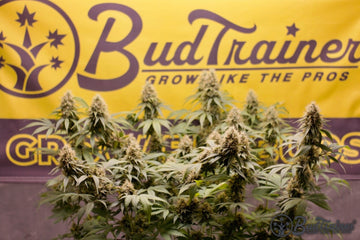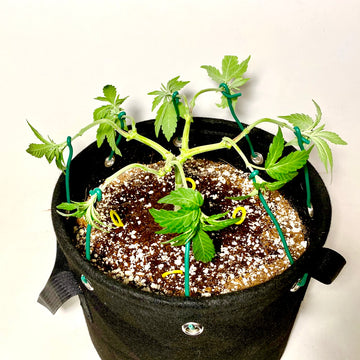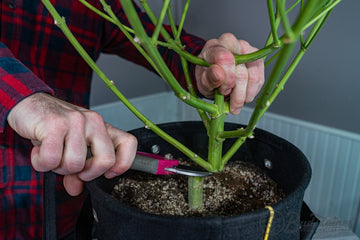DISCLAIMER: Here at BudTrainer we have trained countless plants and broken more branches than we can count. We've also researched everything there is to be researched on the topic, and even got a college degree in commercial cannabis production to learn a bit more. To help you, we have gathered all of our knowledge and put it together in a way that is clear for you to understand, and easy for you to apply.
_______
Experience level: Intermediate
When to start: In final pot, after 5th node appears
Space needed: 2' by 2' per plant, or 3' by 3' if you want to push it
Manifolding Clones: recommended (but nodes might not be symmetrical)
Manifolding Auto-flowers: not recommended (not enough time to recover)
_______
What you need:
- Soft garden ties
- Pruning shears or thin tip scissors
- Hole punch or a pointy knife (or use a training pot)
- LST clips for training your plant at later stages (optional)
- Grafting tape or duct tape (in case of accidents)
Advantages of Manifolding cannabis plants:
- Higher concentration of cannabinoids on top colas
- Arguably increases yields, however, it may not
- Larger colas and less popcorn bud
- More airflow through the canopy and fewer pests
- Creates lower profile and more bushy plants
- The easiest High-Stress Training (HST) technique
Disadvantages of Manifolding cannabis plants:
- Takes long-ish on vegetative stage (min 6 weeks)
- Training can be time consuming
- May or may not decrease overall biomass and yield
- Can be prone to bud rot and other molds (outdoors)
- Stressful for the plant
So what defines a Manifold, really?
A Manifold, by its definition, comes from the words many and fold, just like twofold or threefold, and it means a multiple of something. A Manifold is also defined as a cluster of exhaust pipes that come from a combustion engine that connect to one main exhaust pipe.


In the cannabis world, however, a Manifold is a training technique that was devised by a famous grower by the name Nebula Haze, and since then the Manifold has gone through multiple iterations. Today, there are many different forms of a Manifold, and they all serve the same purpose: to split the plant from one cola intomultiple.
A classic Manifold (the original one from Nebula Haze) involves a plant that has been topped twice in sequence - the first time splitting it into 2 main branches, and the second time splitting it into 8 main branches. Another way to split a Manifold is from 1 main branch into 4, and then from 4 into 8 or 16. This is different than a mainline, for example, where you go from 1 main branch to 2, from 2 branches to 4, and then from 4 branches to 8.
A simple Manifold, on the other hand, simply involves topping the plant twice: the 1st time splitting it into 4 main branches, letting it grow until the 5th node on those new branches, and then topping it a second time, at which point you will have 20 or so colas growing out of the 4 main branches - just like the plant in the picture below. We will be focussing on a simple Manifold in this article because it is easier to do and doesn't stress the plant as much.


BEFORE GETTING STARTED
BudTrainer tip #1: do not use thin strings or wires to tie your plants since they will cut through the epidermis (the outer skin), which will limit the ability of your plants to transport sugars and thus to grow. Instead, use rubber-covered ties that are soft and won’t hurt your plants, like the extra thin and soft BudHuggers.

BudTrainer tip #2: if you break any branches while doing this, don’t worry - we’ve broken countless branches in the past, and we assure you that your plants will recover in no time. Just keep some grafting tape or duct tape with you in case you have to glue a branch back together. It works 90% of the time.

BudTrainer tip #3: when choosing which branches you want to train, make sure that you pick the stems that are still soft and bendy. If they appear hard and woody they are likely to crack, and sometimes you will not be able to recover from that damage.


______
MANIFOLD: THE PROCESS


Step 1 - Preparing pots
When: Right away
NOTE: fabric pots are better for your plants (and the environment!) since they allow the sides of the media to breathe, which in turn prevents root circling. With fabric pots, the roots of your plant are always growing from the inside out, which makes them much stronger and ultimately allows your plant to yield more bud.
Before you even plant your seed or transplant your seedling, punch holes around the edges of your final pot. We like to punch 8 holes per pot in a pizza-like fashion so that they are well-distributed. Use your hole punch or knife for this. Alternatively, use a training pot that already comes with holes.

Training pot with reinforced holes
_______
Step 2 - Topping #1
When: After your seedling has started showing the 5th node (each node is a pair of opposite leaves + growth sites). In the picture below, the 5th node is just starting to come out.


Cannabis plant with 5 nodes, ready to be topped
NOTE: Many growers wait far too long to top their cannabis plants, at which point they are cutting out a really thick piece of stem and wasting all of that energy that the plant put into it. We personally prefer to top as soon as the 5th node pops its head out, like in the girl scout cookies above.
This one is quick: just top your seedling above the 3rd node (read this article to understand the science and the method behind topping), and remove the 1st set of leaves and growth sites (the little shoots that grow out from the base of the leaf). Alternatively, you can choose to leave only the leaves on the 1st and 2nd nodes - what is important is to remove the growth sites (see video below).
_______
Step 3 - Training #1
When: 7 to 14 days after topping
At this point, those 4 little shoots should be long enough (4" or so) such that you can start tying them down in a cross shape using your anchor stakes or training pots, and also your garden ties. Make sure that your shoots are nearly horizontal, and don’t worry if your leaves are facing down. They will turn back up within 24h.
As you can see below, I topped this plant at the third node 10 days ago, and now it has 4 main branches that I am tying down in a cross shape.


_______
Step 4 - Topping #2 + Defol/Pruning #1
When: 10 to 14 days after Step 3. At this point, the 4 main branches will fill up with smaller growth sites and leaves.
Topping (for the second time): now that the 4 main branches filled up with leaves and new growth sites, it is time to top each of each of them one more time, forcing all of the smaller growth sites to grow into thick and juicy colas. In order to accomplish this, top each of the 4 branches at the last bud site, and leave 4 to 6 nodes per branch. You should have a total of 10 or so growth sitesfor each of the branches.

 Where to top a cannabis manifold for the second time
Where to top a cannabis manifold for the second timePruning: after you topped, select all of the growth sites that are weak (in each pair there is usually one strong and one weak shoot), and remove them. This will allow the larger bud sites to take up the energy and grow even stronger. After this "selection" process, you should be left with 5 to 8 strong growth sites on each branch.


Defoliation: lastly, remove any old leaves that are not collecting light, and anchor the side shoots/branches to the ground or to the holes in your pot. This will cause your plant to stay flat and your airflow to increase.
_______
BudTrainer Tip#4: We personally don’t like to defoliate like crazy, but we understand that some people do. When in doubt, just remember that you can always cut another leaf or branch, but you can never put them back. However, if you are having pest issues, then it is important to remove all affected leaves in order to help reduce the spread.
_______
Step 5 - Flowering & Training #2
When: 1 to 2 weeks after the last topping/defoliation. Your plant is ready to flower now.
If you are growing outdoors, you can continue topping your branches every 2 weeks in order to multiply them into even more colas - just make sure to stop topping at least 2 weeks before flower, which usually happens in late July.
If you have LST clips and your branches are growing outside of your pot, this is the time to start using them - so go to town on bending those branches while you can! You can also continue using your training pot, anchor stakes, and garden ties in order to widen the canopy even further.


Prepping a cannabis manifold and prepping for flower
_______
Step 6 - Defol/Pruning #2
When: After week 3 (or day 20) of flower
This is your last opportunity to defoliate before the plant starts putting on weight. So go ahead and remove all lower leaves that are not catching light, all leaves that are blocking airflow in the middle of the plant, and also all yellowing/dying leaves. Leave only enough leaves to cover the canopy area (i.e. don’t leave holes in the middle of your plant).
At this stage, your plant will stop growing in height and will start growing in thickness, which means it’s your last chance to train any branches. If you have LST clips, you can still use them one last time. They will help widen your canopy so that your colas can get even bigger!
_______
Step 7 - Defol/Pruning #3
When: 1 to 2 weeks before harvest.
This is the final stretch, which is when your plant is filling up those trichomes with cannabinoids and still putting on girth. At this stage, we recommend you do one last aggressive defoliation and remove all leaves that are small, yellowing, not getting enough light, blocking airflow, and blocking light from the top of other colas. This will also help tremendously during harvest time, when you won’t have nearly as much to trim.


That’s it, folks! This concludes your manifolding journey and it’s time to reap the fruits (some fine-ass awesome buds) of your labor.
As always, happy growing!
P.S. after harvesting, we prefer to hang dry, and then dry trim. We recommend drying for 5 to 10 days at 60% relative humidity (makes for a slow drying process), and then we cure everything in glass jars for another 21 days (burping it daily).
Want to take your cannabis training to the next level? Check out BudTrainer's unique selection of cannabis training equipment.





